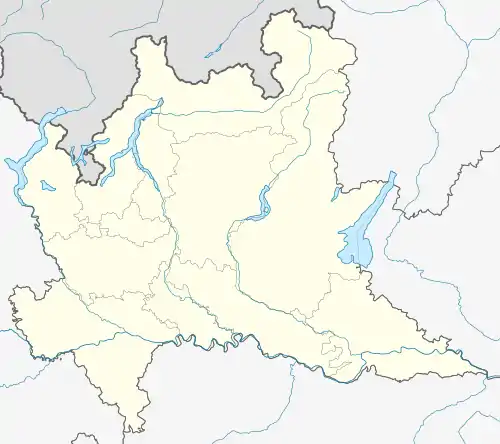Manerbio
Manèrbe | |
|---|---|
| Città di Manerbio | |
 Coat of arms | |
Location of Manerbio | |
 Manerbio Location of Manerbio in Italy  Manerbio Manerbio (Lombardy) | |
| Coordinates: 45°22′N 10°08′E / 45.367°N 10.133°E | |
| Country | Italy |
| Region | Lombardy |
| Province | Brescia (BS) |
| Government | |
| • Mayor | Samuele Alghisi |
| Area | |
| • Total | 27.81 km2 (10.74 sq mi) |
| Elevation | 64 m (210 ft) |
| Population (2011)[2] | |
| • Total | 13,195 |
| • Density | 470/km2 (1,200/sq mi) |
| Demonym | Manerbiesi |
| Time zone | UTC+1 (CET) |
| • Summer (DST) | UTC+2 (CEST) |
| Postal code | 25025 |
| Dialing code | 030 |
| Patron saint | St. Lawrence |
| Saint day | August 10 |
| Website | Official website |
Manerbio (Brescian: Manèrbe) is a town and comune in the province of Brescia, in Lombardy, northern Italy. It received the honorary title of city with a presidential decree on May 14, 1997.
Toponomy
The name Manerbio derives from Latin Minervium, due to the ancient necropolis found in its territory which was sacred to Minerva, a Roman goddess.[3]
History
The territory was inhabitated since the Neolithic. During the Bronze Age, where are actually present the Madonna della Stalla and the Fornasetta farmhouses, there were two etruscan villages. Afterwards, the Celts inhabitated the area. In the Manerbio countryside, has been founded some celtic phaleras from the 1st century BC (now contained in the Santa Giulia Museum, in Brescia) and 4200 dracme padane, silver money from the 2nd and the 1st century BC.
_-_Foto_Giovanni_Dall'Orto%252C_25_Giu_2011.jpg.webp)
During the Roman era, Manerbio (lat. Minervium) was crossed by the Via Brixiana, a Roman consular road which connected Cremona (lat. Cremona) to Brescia (lat. Brixia), from which Roman roads passed and then branched out towards the entire Cisalpine Gaul.[4] Between the 1st century BC and the 3rd century AD, in Manerbio was located a necropolis sacred to Minerva.[3] During this period, in Manerbio was also located at least five roman villas.
During the Middle Ages, in Manerbio was located a castle which during the conflict between Guelphs and Ghibellines get besieged and destroyed by the Holy Roman Emperor Henry IV (1191) and by the King of Sicily Charles of Anjou (1271). Due to the conflict between the Duchy of Milan and the Republic of Venice, it get renewed and engaged in sieges several times.
During the Venetian rule, the town was at the head of its Quadra.
Manerbio began to be a point of reference for the neighbouring town when, due to the Battle of Solferino (1859), arose many rescue facilities which subsequently evolved in a hospital.
In 1907 started the Lanificio di Manerbio's activity, which became Marzotto in 1927. It was the biggest industrial building in the Bassa Bresciana until its closure (2003).[5]
Transportation
Manerbio has a railway station on the Brescia–Cremona line.
Notable people
- Angelo Aimo, Italian retired footballer[6]
References
- ↑ "Superficie di Comuni Province e Regioni italiane al 9 ottobre 2011". Italian National Institute of Statistics. Retrieved 16 March 2019.
- ↑ ISTAT Archived 2016-03-03 at the Wayback Machine
- 1 2 "Scoperto il "triangolo di Minerva" tra Lombardia e Veneto" (in Italian).
- ↑ "VIA BRIXIANA".
- ↑ "MANERBIO".
- ↑ "Angelo Aimo, anima e sostanza degli Allievi della Vaianese" (in Italian). Il Terreno. 25 January 2011. Retrieved 21 February 2015.